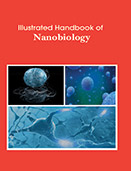Nanotechnology

Life is an accumulation of several nanoscale mechanisms. The human body is made up of almost 5,000 billion cells, which assimilates to form tissue, organ, organ system, but each of them follow specific nanoscale practices to generate and drive life. The consideration of life in our mother earth exposes that biology starts with the establishment of nanoscale materials and mechanisms. Nanoscience is the branch of science in which size matters. It is a multidisciplinary field where a wide range of applications such as using bionanomaterials in engineering or engineered nanomaterials in biology and medicine are studied with diverse viewpoints.
Illustrated Handbook of Nanobiology aims to offer an overview about what nanobiology is and how it is facilitating and impacting on the current developments and trends in medicine.
Biological systems are inherently nano in scale. Unlike nanotechnology, nanobiology is characterized by the interplay between physics, materials science, synthetic organic chemistry, engineering and biology. Nanobiology is a new discipline, with the potential of revolutionizing medicine: it combines the tools, ideas and materials of nanoscience and biology; it addresses biological problems that can be studied and solved by nanotechnology; it devises ways to construct molecular devices using biomacromolecules; and it attempts to build molecular machines utilizing concepts seen in nature. Its ultimate aim is to be able to predictably manipulate these, tailoring them to specifi ed needs. Nanobiology targets biological systems and uses biomacromolecules. Hence, on the one hand, nanobiology is seemingly constrained in its scope as compared to general nanotechnology. Yet the amazing intricacy of biological systems, their complexity, and the richness of the shapes and properties provided by the biological polymers, enrich nanobiology.
This Illustrated Handbook of Nanobiology is a student-friendly introduction to core engineering topic. This book introduces mechanical principles and technology through examples and applications, enabling students to develop a sound understanding of both engineering principles and practices. The interface of nanotechnology and biotechnology (nanobiotechnology) has produced tremendous applications in the domain of human health. Examples include the use of non-bleaching fluorescent nanocrystals (quantum dots) in place of dyes pulled glass capillaries with nanoscale tips utilized for injection of membrane-impermeable molecules (proteins, DNA). Another example is the use of carbon nanotubes (CNTs) for the delivery of biomolecular components to cells and smart biohybrid materials that enhance technologies by providing new avenues for regulating the activity of protein and DNA components.